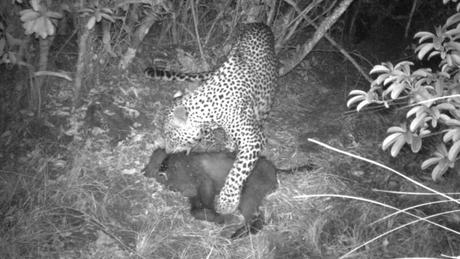On the 15 th of July, Zina and Allison, two of our primate researchers, heard a loud commotion from the baboon troop they were following. Upon investigation, they found that one of the collared baboon females, Perry, was in a terrible state. Unsure of whether she was attacked by another baboon, or by something else, they called it in on the radio. Andy and Philip, our Primate Research Coordinator and Community Engagement Officer, went to investigate.
"Upon arrival we found Perry lying on her side and occasionally trying to get up. She had sustained major injuries to her head and her arm seemed to be broken", said Philip. "We couldn't see any leopard tracks or any other signs of a predator and kept monitoring her to see if she would recover. Close by a bushbuck was alarm calling in terror. Clearly, something was scaring it." That evening Andy and Philip put up some camera traps to see if we could capture what was going on, and then left to let nature take its course.
The next morning, Perry was found a few meters from where she had been lying the previous morning, and still alive! There were no images of predators on the cameras. Were Perry's injuries caused by another baboon in a fight? Or was it a leopard? We still did not know. She looked to be in a better state than she was the previous day, so we left the cameras to further monitor what happened. "Baboons are tough animals and I've seen a few that have bounced back from near death and horrible injuries", said Andy who has worked with baboons for more than 3 years.
Philip and Andy returned the following morning at 4 am to remove her GPS collar, since this could have aided her chances of survival. However, she was completely missing... "We started tracking her with the VHF and kept getting a clear signal, but then it would disappear as soon as we got close. So we started again and the same thing happened, time and time again. We had our suspicions, but weren't sure what was wrong with the collar", said Andy. Eventually, we found baboon hair scattered over the grass (as leopards usually do with their kills), covered in fresh blood and saliva. "At that point we were sure it was a leopard, and it was close!", said Philip. Common sense then took over, as it's not the best idea to stumble around in the dark following a leopard and its kill.
When the camera images were checked back in the office, Philip realised they had missed Dexter, a big male leopard, by just 17 minutes! Even so, they got within 30 meters of him and his kill. The intermittent VHF signal was probably Dexter dragging his breakfast away from those pesky researchers! Later that day we returned to retrieve the GPS collar that Perry had been wearing. Only a few small signs of her remained. We found her skull, which had two big puncture holes where Dexter's teeth had gone straight through. The collar had been damaged too. It really was a ferocious attack and astonishing that Perry lasted as long as she did. Baboons really are amazingly resilient animals, but some foes are just too big to overcome.

